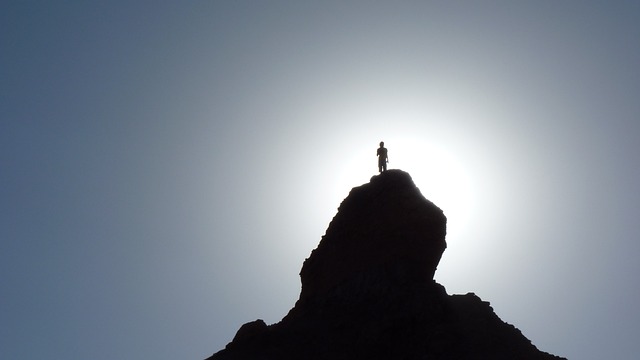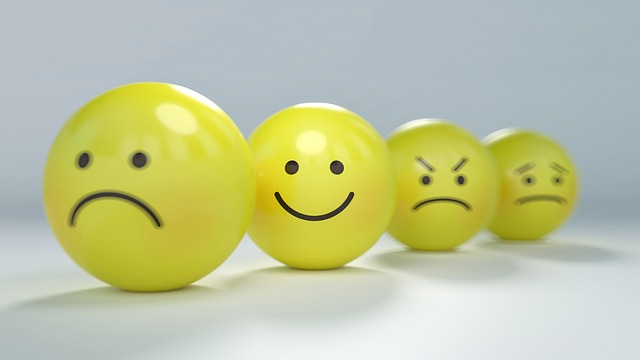What if accomplishment could be as easy as rolling a ball down a hill?
It is when you have unlimited potential energy. Instant access to creativity, flow, and achievement is a single thought away.
If you could achieve anything with ease, how would you want to impact the world?
You get in your own way. Struggling with imposter syndrome and self doubt, accomplishment becomes difficult. If you suspect you block yourself with the way you think, read on.
Cultivate easeful achievement. Learn to work without stress or pressure. Clarify your mind to accomplish more. Read this article to find out how.
Hustle and Grind

The hustle and grind culture would have you believe the path to achievement is through effort and motivation. Have more discipline. Rid yourself of excuses. If you aren’t achieving what you want in life, you simply aren’t trying hard enough.
This looks like a good idea on the surface, and the math of it seems to add up. More focus and determination lead to more action. To get more out of yourself, add more drive. Makes sense: add more to get more.
What if these ideas are taking you in the wrong direction? You actually work better when you don’t pressure yourself. Instead of adding, subtract. The less thinking you have about accomplishment, the more you can achieve. Subtract pressure, imposter syndrome, and fear to get more. Subtracting makes the entire process smoother.
The Trap of Motivation
When I was a middle school English teacher and a weight loss coach, motivation fascinated me. Wanting secret tools and techniques that would motivate my students and clients, I read books and books on motivation. I thought I was learning how to cultivate it. Together, my clients and I worked on discipline and self-motivation. I asked questions about what motivated them and encouraged them to keep going.
I thought I was helping, but I actually blocked them from achieving their goals. I only added to the pressure they already put on themselves. My clients didn’t need to create motivation. They have it already when they stop getting in their own way. Motivation and discipline isn’t cultivated, it is revealed.
Potential Energy
To access more energy for accomplishment, let’s travel back to middle school science class. Groan at me all you want, but I promise it will be worth it. If you are like me, you blanked out that entire period of your life, so I will review the concepts.
We will begin with energy itself. In science, we learned about types of energy: gravitational, mechanical, theremal, electrical and more.
Knowing how energy works will help you achieve what you want. We will focus on two types of energy here: kinetic and potential.
Kinetic energy is energy in motion. It is activated energy. Think of a traveling car, a rolling bowling ball, or a falling ax.

Potential energy is energy that has the possibility of being in motion. It is not kinetic energy yet, but it could be. A stretched out rubber band is an example of potential energy. A ball on the top of a hill has potential energy.
What could you accomplish if unlimited potential energy was available to you at all times?
Would it surprise you if I told you it is?
Each person is connected to the creative power of potential energy. The signal of possibility is within us at all times. We can see the results of the potential energy’s creative genius all over the world. The variety of the creative expression that surrounds us is astounding. Yes, it is in art, music, and books. Also, look for it in relationships, business, and even mathematics.
Wherever creativity flows, find the magic of potential energy.
Turn Potential Energy Into Kinetic Energy
Starting from potential is easy. It is when we aren’t connected to potential energy that getting started becomes hard. Much like a train slowly gathers speed to get itself rolling, we have to work hard to build up steam. Without potential energy, the only way to begin is through motivation, drive, and effort. It is like starting from the bottom of a hill. This initial challenge is what stops most achievers from even trying.
What if getting started didn’t have to be so hard? Potential energy is ready to be activated. Like a taut rubber band, it needs only a small initial action to be released. Starting with potential energy is like starting from the top of a hill. A simple push is all it takes to get the ball rolling.
Starting from the top of the hill doesn’t require all the drive, determination, and motivation I tried to give my weight loss clients. Potential energy becomes kinetic energy on its own. Even though we are the one doing it, it doesn’t feel like we are doing anything. Work isn’t a challenge because we don’t see it as a challenge. The experience flows through us.
Defy Gravity
Working from potential is enjoyable because we become easefully present with each task. We find potential energy in the absence of stress and pressure. Energy in motion tends to stay in motion, so continuing with work doesn’t take much effort. The momentum carries us. Like a spaceship past orbit, we only need minor course corrections.

If you were a spaceship, would you rather start on the ground or from orbit? Beginning a project from hard work is like starting from a launchpad on earth. We need a massive amount of energy to break through the atmosphere of our own thinking. Starting from potential energy is like starting in space. There is a weightlessness to our work. When we access potential energy, accomplishment becomes more effortless.
The only difference between working from potential energy and working from effort is in our minds. Potential energy wants to become kinetic energy. Work can become as easy as rolling a ball down a hill.
The Static of Thinking
If potential energy is always available, why isn’t creating easier?
We have the ability to interfere with our access potential. This energy is only available when we aren’t blocking it in our own minds. Overthinking, judgements, and distractions create a temporary static that limits potential energy. The broadcast is continual and universal, but the noise of our own mind will drown it out. Usually, this happens without awareness.
We think differently when we access potential energy and when we work from effort. When we think in a potential way, I call it top of the hill thinking. Bottom of the hill thinking blocks potential energy and our ability to achieve.
Top of the Hill Thinking

When there is top of the hill thinking, our minds are clear. We see tasks clearly. As we work from inspiration, actions seem effortless. We push the ball down the hill, and it rolls all by itself. Sometimes we even have to keep up our own creative energy. A sense of ease accompanies top of the hill thinking. We aren’t in a rush, and there isn’t a lot on our minds as we create.
The top of the hill work has its own feeling. We create with lightness and simplicity. To those who access it, work isn’t a big deal. They just do it. There is a natural expression of action.
Working in this way is as easy as brushing our teeth in the morning. We don’t have to hype ourselves up or think hard about brushing our teeth. We don’t need strategies, techniques, and tools to motivate us. The fact that we don’t overthink brushing teeth is what makes it easy. The action makes sense, and we do it as a matter of course.
Bottom of the Hill Thinking
Work feels like a grind. The journey is only ever uphill. Both ways. We use our willpower to move the ball. We push and shove, only to have the roll back down the hill. Stuck and frustrated, we soldier on or give up.
Do you find yourself lost at the bottom of the hill? We want to take the optimal path, but we don’t know the best way forward. Questioning our methods constantly, we hesitate to take action. Each decision seems more difficult than the last. In our confusion, we take half measures and continually change tactics.
We operate from deep fears at the bottom of the hill. Fear breeds doubt. Will we be strong enough? Will we have enough determination? These questions ache in the back of our minds, our own unworthiness clouding way forward. We fear we aren’t good enough. We fear criticism, especially from ourselves. We may even be afraid of success.
Bottom of the hill thinking doesn’t feel good. Working in this way is like driving a car with the handbrake on. The car will drive, but there is a drag on the engine. Continue to drive and the friction under the hood will start to smell. Just as driving with the handbrake damages the car, working from effort will eventually damage us. We burn ourselves out and then judge ourselves for not accomplishing enough. There is overwhelm, stress, frustration, and fear at the bottom of the hill.
What Causes Bottom of the Hill Thinking?
Top of the hill thinking is simply the absence of bottom of the hill thinking. This is important to realize. Top of the hill thinking, unlimited potential energy, is our default. It is only once the bottom of the hill thinking creeps in that work gets hard.
A montage of two achievers working on a project, one from top of the hill thinking, and the other from bottom of the hill thinking, might look similar. While the two take corresponding actions, there is a world of difference inside their minds. One mind is in flow while the other grinds away. One mind makes the work effortless and the other effortful. The top of the hill achiever can create consistency, and the bottom of the hill achiever will burn out.
All work can be done in an easeful way. The only difference is in our minds.
A Clear Mind
The difference between the two minds is in how they operate. The top of the hill achiever has a clear mind that is able to access fresh ideas, insights, and wisdom. The bottom of the hill achiever has a mind cluttered with thoughts.
Bottom of the hill thinking is often negative. Imposter syndrome, fear, and self doubt block potential energy. We often know negative thoughts get in our way, but positive thoughts block the flow just as easily.
Even affirmations like, “I am amazing at this!” or, “I can do it,” slow down achievement more than they help. Positive thoughts distract. When we become too preoccupied with how we are doing, we don’t pay attention to what we are doing. Focus on ourselves takes focus away from work. It doesn’t matter what the thoughts are about, any thought gets in the way of the top of the hill flow and ease.
Mental noise makes accomplishing harder. We access potential energy when we are not caught in the gravity of our own thinking.
Under Pressure
Just as there is less air pressure in higher elevation, there is less mental pressure at the top of the hill. Lower elevations have more air pressure. Similarly, more mental pressure is found at the bottom of the hill. This mental pressure is the pressure we place on ourselves to get it right.

The desire to get it right seems like it will create improvement. Criticizing our work might look like a good idea, but it doesn’t help us to make it better. Perfectionism is judgment in disguise. We can’t drive forward if we are looking in the rear view mirror at past “failures.” Pressure doesn’t create diamonds here because we only pressure ourselves, and we don’t operate better under pressure. Creativity flows best in the absence of pressure.
Voltaire said, “Perfection is the enemy of good.” Perfectionism is also the enemy of top of the hill thinking. We don’t improve through analysis. Progress is made in doing. The more we create from the top of the hill, the better we will get. Improvements are made in drafts, not by getting it right the first time.
Pressure, urgency, and stress are helpful signs that we are trying to create from the bottom of the hill.
Where Do You Want to Set Up Camp?

Many achievers live at the bottom of the hill. To them, work is a grind. That’s just how it is. They might even pride themselves on how much they can grind it out. They effort away, never looking up long enough to see there is a top of the hill. Top of the hill and potential energy doesn’t exist in their world. Even if they suspect it does, getting there isn’t a possibility.
Some achievers work with ease and flow at times. Other times, they force from the bottom of the hill. When they find themselves at the top of the hill, they don’t know how they got there. Their journey seems to have more ups and downs than a rollercoaster. It seems like the project itself becomes easier or harder, but they are unconsciously fluctuating in and out of potential energy.
Access to potential energy is never static. The mind shifts. Thoughts change with each moment. Potential energy and flow are always available because our mind can shift at any time. We can drop what is in the way. When the blocks dissolve, we are brought to the top of the hill automatically. Unlimited potential energy is what is left when we subtract mental noise.
Don’t set up camp at the bottom of the hill. Become open to a new way of using your mind when you work. When you disconnect with potential energy, trust that it can be available to you again. When you understand that it is our default state, it will start to come through more often. Potential energy only ever on the other side of your current thinking.
Want more top of the hill thinking? Find tons of ideas to help you access more potential energy and top of the hill thinking in the next article. If you want one on one or group help to guide you to easeful accomplishment, let’s start a conversation.
Please Share
I want more achievers to work with ease and clarity. Please share this article with someone you care about.


Leave a Reply